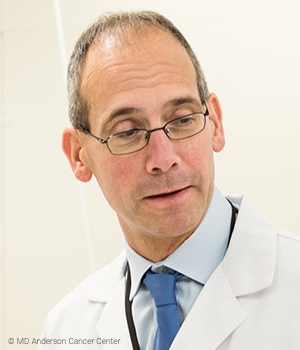Doctor Philip Jones
Drug DesignerAgilent aids multidisciplinary quest to starve cancer cellsAs a drug designer, Philip Jones is always on the lookout for the next medicine to improve the lives of cancer patients.
Jones leads the Therapeutics Discovery Division at the University of Texas MD Anderson Cancer Center, a broad cross-functional team working to develop innovative therapies inspired by the needs of MD Anderson cancer patients. Within Therapeutics Discovery, the Institute for Applied Cancer Science (IACS) is focused on novel small-molecule therapies, and molecules they have identified and developed are showing real promise. That promise lies in their ability to starve certain cancer cells of the energy they need to survive. “A lot of the research we’ve been doing is in the area of cancer metabolism, and we’ve identified vulnerabilities in particular tumor types around certain metabolic pathways,” Jones says. “We have a number of exciting programs that are in the clinic, or about to go into the clinic, exploiting these vulnerabilities and blocking the fuel the tumors need to survive.” "The Agilent suite of instruments allow us to go in and really understand these mechanisms” Jones says.
The IACS team relies on a number of technologies from Agilent to identify the right medicines to advance into the clinic. These include a high-throughput RapidFire system, triple quadrupole and quadrupole time-of-flight mass analyzers coupled with liquid chromatographs, cutting edge metabolomics software, and a real-time Seahorse XF analyzer that is used to monitor the metabolism of live cells. Jones notes that the team also benefits from being part of the largest cancer hospital in the United States: “We have the advantage of being able to tap into our basic researchers who study disease processes,” he says. Jones explains that tumors get the energy to grow and metastasize in two ways: either through glycolysis or oxidative phosphorylation, also known as OXPHOS. “The subset of cancer cells we’re targeting depend very heavily on OXPHOS to survive, so one of the therapies we’ve developed shuts down that pathway,” he says. “Recognizing that glycolysis is not prevalent in these cells, we believe that, by shutting down OXPHOS, we could push those over the edge.” To that end, Jones assembled a drug discovery team to identify molecules with the most potential and set to work. “There are a lot of things that we need to engineer into our molecules—a lot of design and chemical synthesis that goes into that—and we rely heavily on Agilent mass spec platforms to be able to characterize those molecules,” he says. In total, the team made around 700 molecules before deciding that one particular molecule, which goes by the code number IACS-10759, was the right one to advance.”
With approval from the U.S. Food and Drug Administration, IACS-10759 is now in clinical trials. “All the while we’ve been working on this, we really wanted to understand how the molecule was working and what it was doing to the tumor cells. That was where we were able to collaborate with a number of Agilent scientists with metabolomics expertise over on the west coast. That included targeted metabolomics, where we were looking to see what was happening to specific metabolites using the triple quadrupoles, as well as untargeted metabolomics, where we were able to leverage the Agilent quadrupole time-of-flight instrument and really, in an unbiased manner, leveraging the Agilent software, see what was changing in these cells,” Jones says. “Through some really elegant work we were able to get a roadmap of how the various nutrients and building blocks were changing in relation to IACS-10759 treatment.”
Another Agilent technology that played a key role in the research, he points out, was the Seahorse XF analyzer. “Seahorse allows us to take live cells and look at their oxygen consumption rate (OCR) and what is happening to those cells in real time,” Jones explains. “In our preclinical studies, we were able to take these cells directly from some of our preclinical models, isolate them, and put them on the Seahorse instrument. We were able to show how IACS-10759 blocked OCR, what drug levels were necessary to achieve that, and also determine why some cells were highly sensitive.” He says that the team is now using all that know-how in the ongoing clinical trial. “The phenomenal thing about being here at MD Anderson is that, as our patients are being treated with our drug, we can collect samples from them in real time,” Jones says. “We can isolate the cancer cells, purify them, and put them onto the Seahorse right away. That gives us a real-time snapshot of what our drug is doing to those cancer cells, we’ve been able to show that it’s having a significant biological impact.” He estimates that IACS-10759 is still probably three to four years from going to market. “But it’s very exciting how leveraging the Agilent platform has enabled us to push this and other therapies forward,” he says. For Research Use Only. Not for use in diagnostic procedures. |

Philip Jones, PhD
Vice President, Therapeutics Discovery |
Selected publications
|
An inhibitor of oxidative phosphorylation exploits cancer vulnerability. |